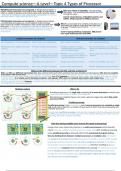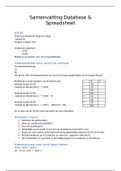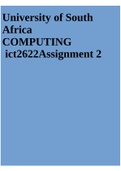RISC(Reduced instruction set computer): A design that produces a RISC uses 4 lines of assembly, 2 for retrieving
simple, cheap integrated circuit with a basic range of instructions, it the values, 1 for providing the product and 1 for
relies on speed as complex instructions take many machine cycles. storing the value.
- They aim to complete a task using simple instructions that will be
executed within a single machine/clock cycle. Used in smart phones, embedded systems and
tablets. Made popular by ARM processors.
CISC(Complex Instruction set computer): A design that produces
a complicated and expensive circuit capable of performing a MULT is an example of a complex instruction as it
large variety of complex instructions, they can be executed with resembles the original command from high level
few cycles.—They aim to complete a task with as few lines as language “Product=num1*num2” - This is 1 line in
possible meaning the processor hardware and circuitry has to be assembly.
more complicated so it can understand and execute a series of
instructions. Used in laptops/desktop computers. X86 proces-
sors made mainly by intel and AMD.
Complex instruction set computer Reduced instruction set computer
•As emphasises is on the hardware, •Can’t make use of Pipelining. •Has simpler Hardware. •Can support pipelining.
•Small code sizes, higher cycles per •Greater energy consumption. •Smaller number of simple, •As the emphasises is on the soft-
second. standardized instructions that ware, the compiler has to do more
are all of fixed length. work
•Makes more efficient use of RAM. •Physically larger, more complex •Smaller in size, less complex •Large code sizes, lower cycles per
circuitry, requires more silicon circuitry required, less silicon so second.
to make so typically more cost- typically cheaper to produce.
ly.
•Multiple Address modes available. •Multiple clock cycles per in- •Single clock cycle per instruc- •Heavy use of RAM. (Can cause
•Large number of complex instruc- •Has more complex hardware. •Low energy requirements. •Fewer addressing modes available.
What are the differences between the RISC and CISC architecture?
RISC and CISC are different instruction sets, they contrast with each other and have their own benefits and drawbacks, CISC aims to complete
instructions with fewest lines, this uses complex instructions which are multiple instructions put into one, this is beneficial for the compiler as
it has to do less work and it makes more efficient use of RAM than RISC however it requires greater energy consumption and requires compli-
cated hardware, it is mainly used in desktop computers and laptops. RISCS aims to complete instructions with simple lines, single machine
cycle per instruction, it also has simpler hardware and is cheaper as less complex circuitry is needed which allows more space for general-
purpose registers and cache however it requires heavy use of the RAM and the compiler has more translation work to do when converting
from high level to assembly language.
Multicore system What is it?
A multicore processor is a single chip containing 2 or more processors in which each
can perform FDE cycles as shown in the diagram.
Manufacturers integrate theses cores onto a physical single chip called Chip multi-
processor (CMP).
Parallel processing
Parallel processing is the simultaneous use of several processors to complete a single
job. A job may be split into a number of tasks each of which may be processed by any
available processor.
For example, parallel processing is achieved by assigning a fetch-decode-execute cycle
to different processors or processing cores.-One could be fetching, the other could be
decoding, the other could be executing.
How does having multiple cores increase the speed of processing?
Having more cores means the processor is a multi-core processor which basically
means there are multiple processing units on a single chip. With multiple processing
units, parallel processing is achieved which is the processing of program instruc-
tions by dividing them between multiple processors or multiple cores, this means
the speed of processing can be faster because for example in a 3-core CMP, parallel
processing could be achieved when one core is assigned to one part of the FDE cy-
cle, the other can be assigned to the next and so on therefore resulting in a faster
processing speed however there are limitations for example if a software has actual-
ly been designed and written to make use of parallel processing and more cores
but also the more cores added onto a chip the longer it takes for the chip to make
sure all cores are in synchronisation.




